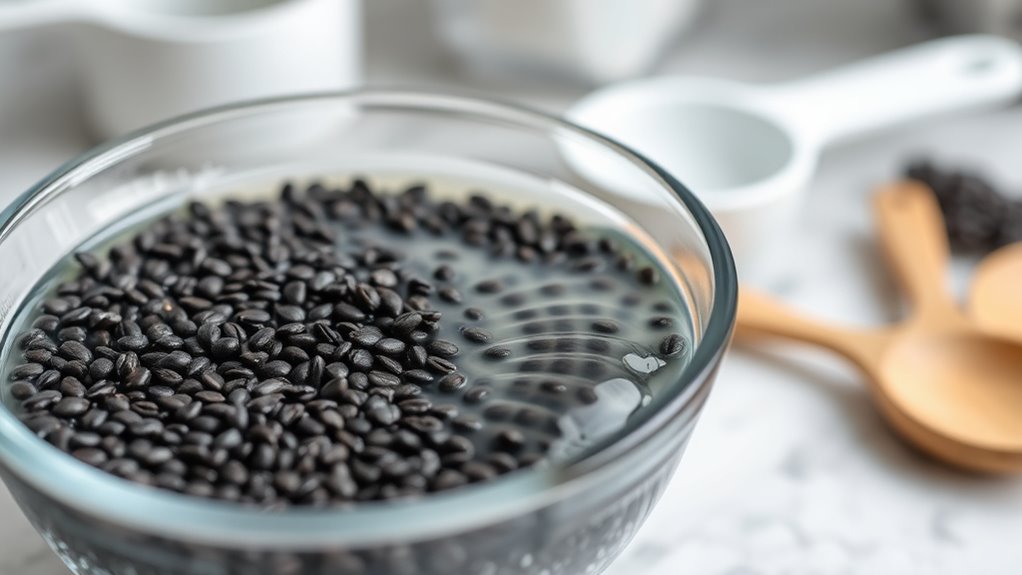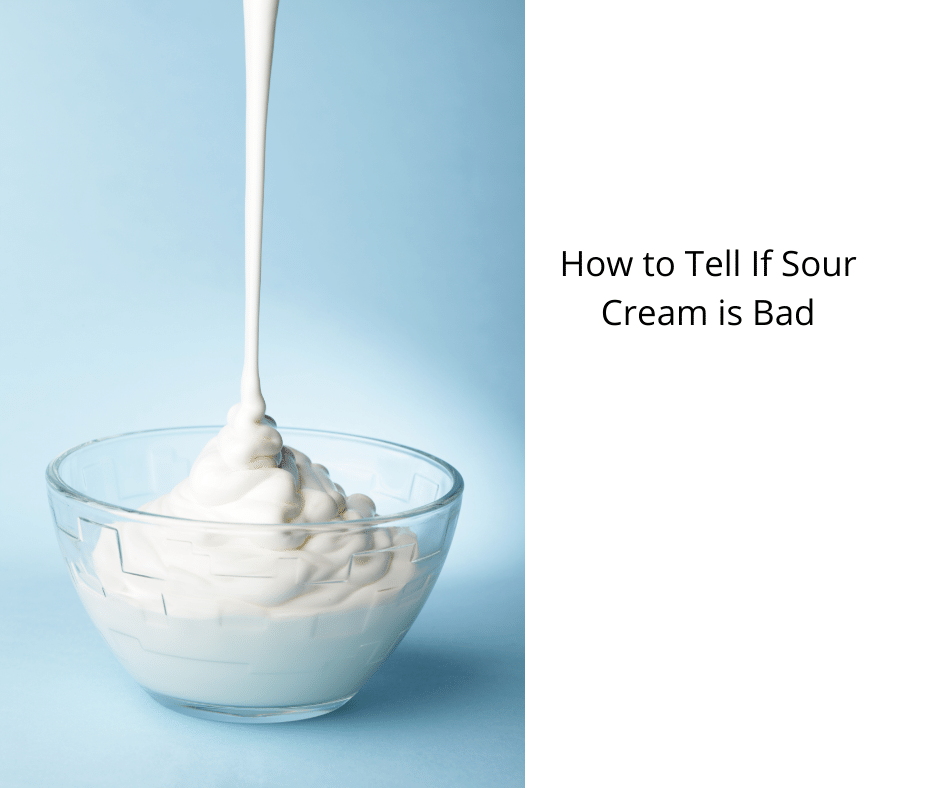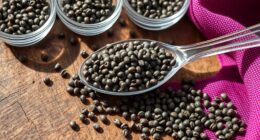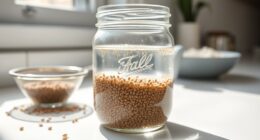To make a chia egg for baking, combine 1 tablespoon of chia seeds with 3 tablespoons of water and stir well. Let the mixture sit for 10-15 minutes until it forms a thick, gel-like consistency. If needed, stir again to guarantee even texture before using as a substitute for eggs in recipes like muffins or pancakes. Want to know tips for perfect results and additional ways to use it? Keep going for more details.
Key Takeaways
- Mix 1 tablespoon of chia seeds with 3 tablespoons of water in a bowl.
- Stir well to combine, ensuring seeds are evenly dispersed.
- Let the mixture sit for 10-15 minutes until it forms a gel.
- Stir the gel again to achieve a uniform consistency before use.
- Use the chia egg as a substitute for one egg in baking recipes.

A chia egg is a simple, plant-based substitute for traditional eggs, perfect for vegan recipes or those with egg allergies. It’s made by soaking chia seeds in water until they form a gel-like consistency, mimicking the binding properties of eggs in baking. Not only is it easy to prepare, but it also offers several nutritional benefits. Chia seeds are rich in omega-3 fatty acids, fiber, antioxidants, and essential minerals like calcium, magnesium, and phosphorus. Incorporating a chia egg into your recipes boosts the nutritional profile while providing a sustainable, cruelty-free alternative to chicken eggs. Plus, because it’s plant-based, it aligns with a variety of dietary preferences and can help you create more health-conscious baked goods.
Making a chia egg is straightforward. You start by mixing one tablespoon of chia seeds with about three tablespoons of water. Stir the mixture well, then let it sit for roughly 10 to 15 minutes. During this time, the seeds will absorb the water and swell, forming a gel that’s thick and slightly sticky. Stir again before using it in your recipe to ensure even consistency. This gel can replace one egg in most baking recipes, such as muffins, pancakes, or cookies. It’s important to remember that the texture of a chia egg is slightly different from a typical egg, but in most baked goods, it provides the necessary moisture and binding ability.
When it comes to storage tips for your prepared chia eggs, it’s best to use them within 24 hours for maximum freshness and consistency. If you prepare a larger batch, store the leftover gel in an airtight container in the refrigerator. Keep in mind that the chia seed mixture might thicken further as it sits, so give it a quick stir before using. If you notice any off smells or mold, discard it immediately. Because chia seeds can absorb odors from the fridge, store the gel away from strongly scented foods to maintain its fresh taste. Always label your container with the date you made the chia egg so you can track its freshness. While it’s convenient to prepare in advance, using it sooner rather than later ensures the best texture and nutritional benefits.
Frequently Asked Questions
Can Chia Eggs Replace Eggs in All Recipes?
Chia eggs work well as egg substitutes in many baking alternatives, but they can’t replace eggs in every recipe. For baked goods like muffins or pancakes, they add moisture and binding, but in recipes needing leavening or structure, like meringues or soufflés, they fall short. You should consider other egg substitutes depending on your recipe’s needs, as chia eggs are a versatile but not universal baking alternative.
How Long Does a Chia Egg Stay Fresh?
A chia egg stays fresh for about 24 to 48 hours if you store it properly. To preserve its freshness, keep your chia seed mixture in an airtight container in the refrigerator. Proper chia seed storage helps maintain its quality and prevents spoilage. For the best results, use your chia egg within this timeframe, as it may develop a sour smell or slimy texture beyond that, indicating it’s no longer fresh.
Are Chia Eggs Suitable for Vegans?
If you’re vegan, chia eggs are a great substitute for traditional eggs, aligning with your ethical considerations. For example, a vegan baker named Lisa successfully baked muffins using chia eggs, avoiding animal products entirely. Chia eggs serve as an excellent vegan substitute, providing similar binding properties. So, yes, chia eggs are suitable for vegans, supporting your commitment to ethical and plant-based baking.
Can I Use Ground Chia Seeds Instead of Whole?
Yes, you can use ground chia seeds instead of whole ones for baking substitutions. Ground chia seed texture differs from whole, becoming a gel-like consistency when mixed with liquid, making it a good egg replacer. Just keep in mind that ground chia seeds may create a smoother, less crunchy texture in your baked goods. Use the same amount as whole chia seeds to achieve the desired binding effect in your recipes.
What Is the Best Liquid to Mix With Chia Seeds?
Think of chia seeds as tiny sponges craving the perfect bath; water is your go-to, creating that gel-like magic. But don’t stop there—try almond milk, coconut milk, or soy milk for richer flavor and added nutrients. Chia seed nutrition shines when paired with these liquid alternatives, giving your baking a boost of fiber and omega-3s. So, choose your liquid wisely to craft the ideal chia egg every time.
Conclusion
Now that you know how to make a chia egg, you’re armed with a versatile, plant-based substitute for eggs in your baking adventures. Think of it as your secret ingredient—like a hidden gem waiting to turn your recipes into masterpieces. With just a few simple steps, you can effortlessly elevate your baked goods, making them healthier and just as delicious. So go ahead, embrace the chia magic and let your baking journey blossom like a spring garden.








